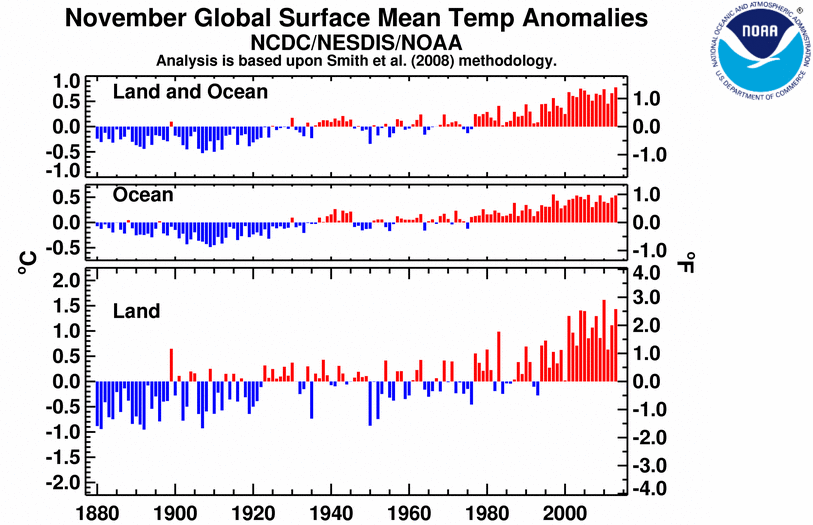Global Analysis - November 2013 | State of the Climate | National Climatic Data Center (NCDC)
•The combined average temperature over global land and ocean surfaces for November 2013 was record highest for the 134-year period of record, at 0.78°C (1.40°F) above the 20th century average of 12.9°C (55.2°F).
•The global land surface temperature was 1.43°C (2.57°F) above the 20th century average of 5.9°C (42.6°F), the second highest for November on record, behind 2010. For the global oceans, the November average sea surface temperature was 0.54°C (0.97°F) above the 20th century average of 15.8°C (60.4°F), tying with 2009 as the third highest for November.
•The combined global land and ocean average surface temperature for the September–November period was 0.68°C (1.22°F) above the 20th century average of 14.0°C (57.1°F), the second warmest such period on record, behind only 2005.
•The September–November worldwide land surface temperature was 1.08°C (1.94°F) above the 20th century average, the third warmest such period on record. The global ocean surface temperature for the same period was 0.52°C (0.94°F) above the 20th century average, tying with 2009 and 2012 as the fourth warmest September–November on record.
•The combined global land and ocean average surface temperature for the year-to-date (January–November) was 0.62°C (1.12°F) above the 20th century average of 14.0°C (57.2°F), tying with 2002 as the fourth warmest such period on record.

I have been reading articles about the low sunspot activity, many are saying that that is indicating a lower TSI output, but the sunspot count is only a proxy, the real TSI was higher than the previous sunspot cycle, due to the lower sun spot count.
However the SOURCE satellite failed several months ago so we no longer have a direct measurement to go by.
SORCE » Total Solar Irradiance Data
The TIM, along with all other SORCE instruments, has been powered off since a battery cell failure on 30 July 2013. The spacecraft operations team is pursuing ways of operating the instrument to acquire more TSI measurements in the current low-power mode. Future TSI measurements are expected to be intermittent and of degraded quality due to thermal and pointing limitations caused by the spacecraft battery issues.
